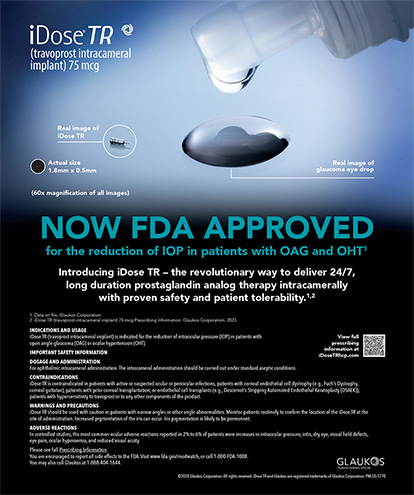According to data available on the FDA Web site, the Bausch & Lomb Technolas® 217A has superb FDA results compared to all the approved lasers in terms ofuncorrected vision, best-corrected vision, safety, and accuracy, and it showed no increase in patients with night vision problems. The data listed on the FDA's site is important because it compares the lasers on an equal basis. Multiple doctors used each laser, and submitted hundreds of cases that were followed long-term and rigorously, prospectively evaluated in a set study. All results were subject to FDA auditing.
ACTIVE EYETRACKING SYSTEM
The Active Eyetracking System is now approved, and has one of the fastest reaction times of any eyetracking system, which I believe is the best objective evaluation of eyetracker responsiveness. In other words, it is important to know the time from when the system samples to the time when it moves the mirrors, which is a set of several different rates. The formula consists of a series that includes how many times the system looks at the eye; the speed of its computer processor; how rapidly it goes through the electronics to the mirrors; how fast the mirrors move; and how fast the laser is firing. The reaction time is based on that entire set of tasks.
The ergonomics of the laser itself are excellent. It has a very fast-moving bed that moves in all axes, X, Y, and Z, and a microscope that lets the surgeon zoom quite far out in order to perform the keratectomy. The optics are also very good. The eyetracker does not require extra steps; it begins tracking as soon as the patient lies down beneath the laser. If the surgeon does not want it to track, he or she pushes a button, but if he or she wants it to track, there are no extra steps to take. Some eyetrackers require that surgeons zero the patient in, or even bring the patient into the clinic on a separate day and dilate them. The Active Eyetracking System does not require dilation or separate visits. In addition, the eyetracker reveals exactly what it thinks is the center; whereas some other eyetrackers make the surgeon estimate the location of the center. Compared to other eyetrackers, the Active Eyetracking System is the easiest to use, and the ergonomics of the laser itself are equally impressive.
HOW THE ACTIVE EYETRACKING SYSTEM WORKS
The Active Eyetracking System is a video-based eyetracker. It shines infrared light on the pupil, producing a very distinct, black pupil and a light-colored iris. Then an infrared video camera tracks the image of the black pupil moving around. All active trackers are active only to a point; they stop tracking and will not allow the laser to fire if the patient moves too far out of the range. Another small but important feature of the Active Eyetracking System is that if the surgeon decides he or she does not want to use the Active Eyetracking System, he or she can turn it off and use the laser without it. Although this feature may sound minor, it is useful for patients with conditions that the eyetracker will not track, such as a large iridotomy, a very dark pupil, or a corneal scar. In addition, the Active Eyetracking System will not turn off if an instrument or Weck sponge is moved across the field.
HOW ZYOPTIX™ WORKS
Zyoptix™ is Bausch & Lomb's new system for Personalized Vision Solutions, which incorporates its Zywave™ Hartmann-Shack aberrometer coupled with its Orbscan®IIz multidimensional corneal measurement device. The data captured by the integrated diagnostic workstation generates the individual ablation profile for use with the Bausch & Lomb Technolas® 217z Excimer laser system to perform the customized treatment. The laser uses a combination of 2-mm and 1-mm diameter flying spots (Figure 3). First, a 2-mm spot is used to correct most of the refractive error by ablating approximately 90% of the corneal tissue. Finally, the spot size is reduced to 1 mm to correct the fine structures, such as higher-order aberrations and create an optimized transition zone. This, combined with a truncated Gaussian beam, results in maximum smoothness of the corneal bed, minimal thermal effects, less tissue removal, and a wider, fully corrected optical zone in an efficient treatment time.
RESULTS WITH ZYOPTIX™
We have completed our second phase of customized ablation studies with Zyoptix.™ There are three investigators: myself, Daniel Durrie, MD (Kansas City, MO), and Scott MacRae, MD (Rochester, NY). In the first phase, we performed a study with 45 patients, who each had one eye treated with Zyoptix™ and the other eye treated with regular plano scan. This statistically powerful study also had the eyes of each patient matched within a tight range. The study was double-masked; neither the patients nor the examiners knew which eye had been treated with which system. The study had very good results, and the FDA rapidly approved the study for the second phase, which included approximately 300 eyes. We have also finished that phase, also with positive results. The patients' numbers were excellent, and the patients seemed to appreciate the improvement more than regular LASIK patients—the quality of their vision was subjectively better. Many of the patients recovered with better than 20/20 vision. Oddly, we began to think of 20/20 as “suboptimal,” if not an outright failure! The patients were excited about their vision as well. Objectively, their contrast sensitivity, accuracy, safety, and efficacy were excellent, so we are very pleased with the results. n
Text extracted from Dr. Slade's presentations, ?Zyoptix Results to Date,? and ?Bausch & Lomb Technolas® 217 Eyetracker,? hosted by Bausch & Lomb on November 12th, 2001, at the AAO meeting in New Orleans, Louisiana.


